About the technology
Ultraviolet disinfection technology is based on the bactericidal action of UV radiation.
UV irradiation
- is a physical method of disinfection based on photochemical reactions that cause irreversible damage to the DNA and RNA of microorganisms. As a result, the microorganism loses its ability to reproduce (inactivated)
UV disinfection technology can be used both in water treatment and wastewater treatment systems and in air and surface disinfection.
When selecting UV equipment, it is important to ensure that the UV dose is sufficient to provide the required concentrations.
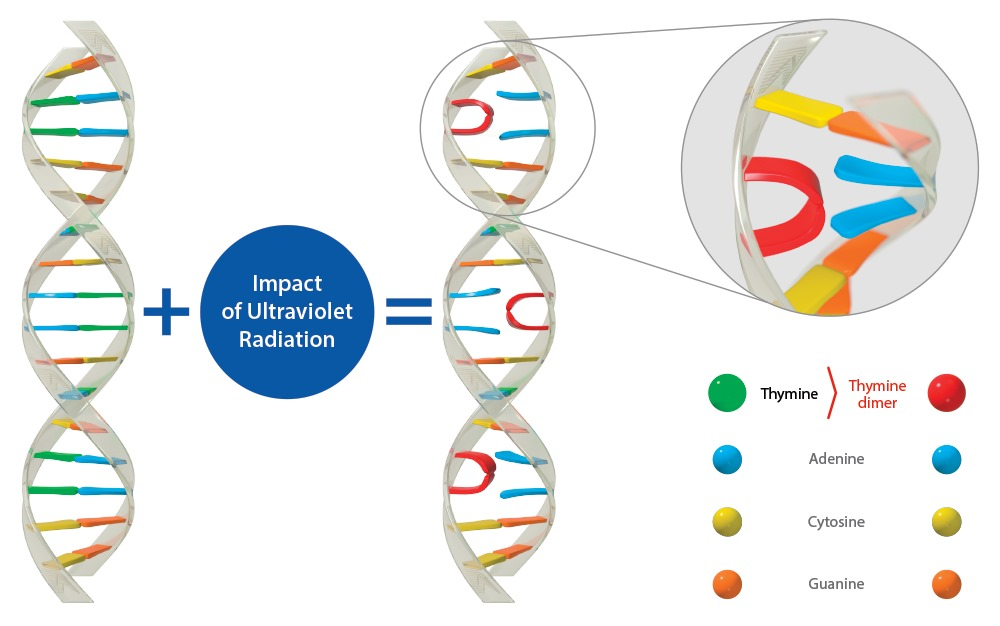
What is UV radiation?

Ultraviolet radiation is electromagnetic radiation that covers the spectral range between visible light and X-rays. UV rays are invisible to the human eye. The wavelengths of UV radiation lie in the range from 100 to 400 nm). The term is derived from Latin ultra (over, beyond) and English violet (purple).
Low-pressure UV lamps emit UV light with a wavelength of 254 nm, which is close to the peak sensitivity of microbial DNA and RNA at 265 nm.
Ultraviolet of the range (200-280 nm) has the highest disinfection efficiency against bacteria, viruses and protozoa, therefore it is called bactericidal. UV disinfection is particularly effective against chlorine-resistant pathogens (e.g. Giardia and Cryptosporidium).
UV radiation does not cause adaptation in microorganisms, and thus the growth of resistance in contrast to chemical reagents, does not change the taste, colour and smell of treated water.
UV radiation with a wavelength of 254 nm, generated by low-pressure lamps, does not lead to the formation of by-products, which is especially important for:
- water treatment in the drinking water supply;
- water for reuse, such as irrigation, watering or manufacturing purposes;
- water for recycling systems in aquaculture;
- air and surfaces desinfection.
Research and practical experience show that a certain amount of UV radiation is required to inactivate each pathogen. To achieve the required level of disinfection, it is important to provide a sufficient UV dose.
What is the UV dose and how big should it be?
UV dose is the amount of UV radiation delivered to a microorganism to inactivate it. UV dose is measured in mJ/cm². Each pathogen requires a specific UV dose for inactivation. This is due to the different structure and composition of the protective shell of microorganisms
In accordance with MUK 4.3.2030-05, the minimum radiation dose for drinking water treatment is 25 to 40 mJ/cm². In accordance with MU 2.1.5.732-99 and MU 2.1.5.1183-03, the minimum irradiation dose for the treatment of wastewater discharged into a water reservoir and reused in technical water supply systems is not less than 30 mJ/cm². If the UV dose is lower, it will lead to non-compliance with the requirements for the microbiological quality of the water after disinfection.
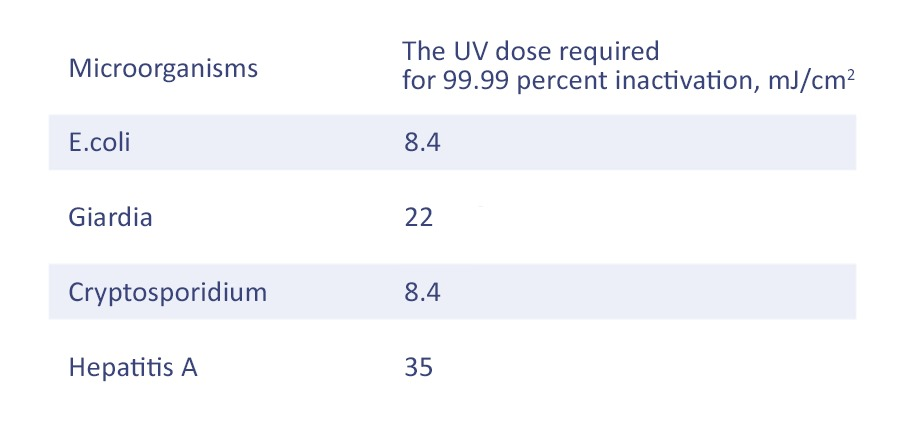
How is the UV zone ensured?
The UV dose depends on the UV intensity and the irradiation time. The dimension is mJ/cm².
UV intensity is determined by the power, the number of UV lamps and the transmittance of the medium.
When treating water with a high transmittance factor, the UV intensity required for disinfection is achieved with a lower UV lamp power, and with a low transmittance factor with a higher UV lamp power.
The use of more powerful lamps leads to a reduction in the size of UV installations (LIT equipment uses low-pressure amalgam lamps with a power of up to 1 000 W).
The irradiation time is determined by:- water flow rate. The higher the water flow rate supplied to the equipment, the shorter the irradiation time, and therefore the lower the UV dose in the same UV reactor;
- equipment geometry. For example, the smaller the diameter of the UV reactor, the shorter the irradiation time will be for the same flow rate.
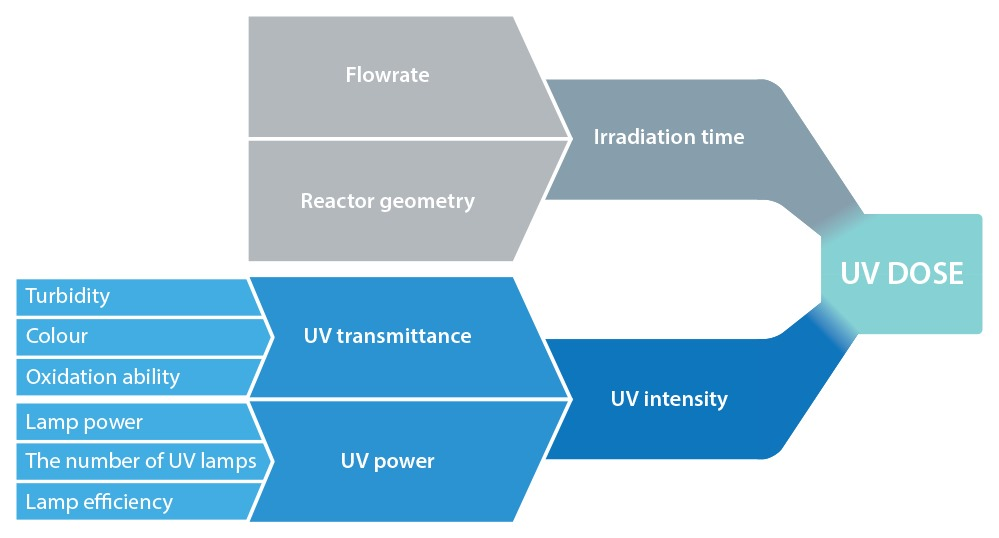
UV transmittance factor
The transmittance depends on the content of organic compounds in the water: the less organic compounds there are, the higher the transmittance.
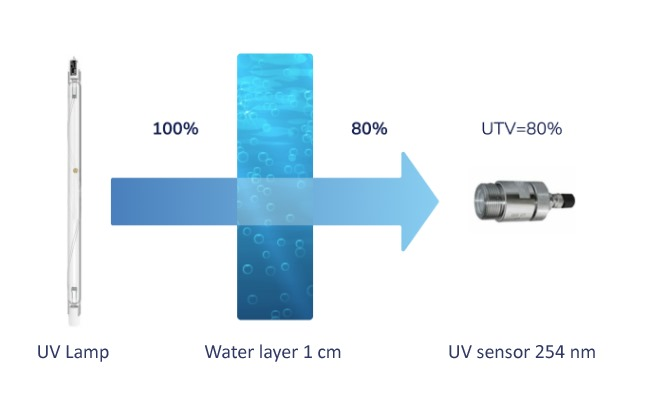
Typical UV transmittance coefficients depending on the water source
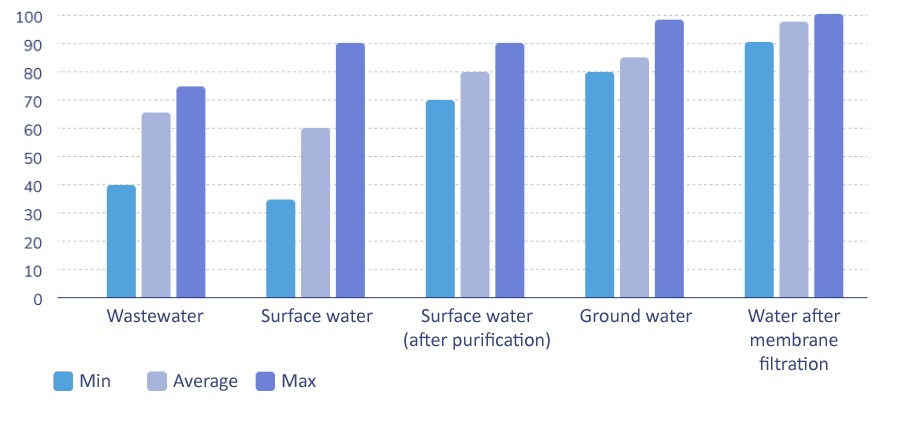
The transmittance value can be determined from the values of physico-chemical water parameters such as colour, turbidity, acidification or COD. Changes in the values of water parameters are seasonal in nature. For transmittance estimation, data over a long period of time is used to identify the worst values. The UV equipment must be able to disinfect effectively at the worst value of the UV transmittance.
When selecting equipment for air and surface disinfection, the transmittance factor is assumed to be 100%.
Water consumption
The water flow rate determines the time of microorganisms in the irradiation zone. The higher the flow rate, the shorter the irradiation time, and therefore more power is required to provide the necessary UV dose. During the day the water flow rate through the unit can vary. LIT equipment is selected to ensure reliable disinfection at peak flow rates.
During periods when the flow rate through the UV system is less than the maximum, LIT's systems automatically activate lamp power control, saving up to 50% of electricity.